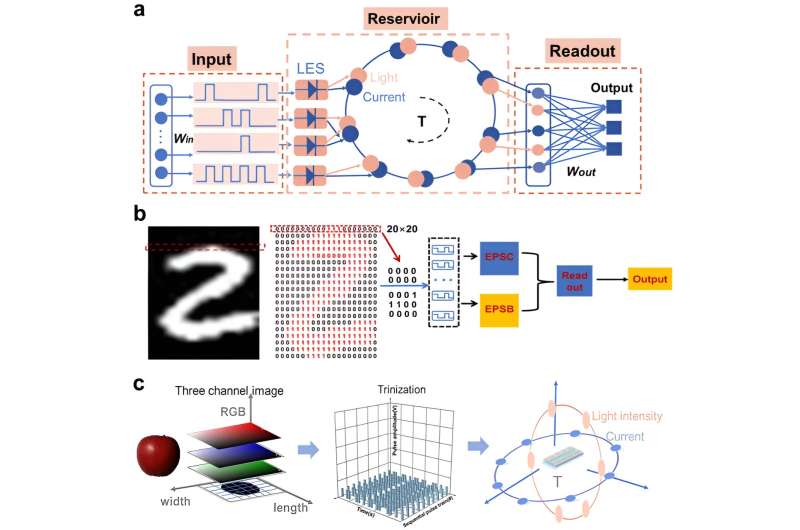This article has been reviewed according to Science X's editorial process and policies. Editors have highlighted the following attributes while ensuring the content's credibility:
fact-checked
peer-reviewed publication
trusted source
proofread
Scientists develop physical node reservoir computing based on light-emitting synapses

With the development of artificial intelligence technology, various artificial hardware neural networks such as recursive neural networks, convolutional neural networks, and spiking neural networks have been proposed to meet the efficient processing and recognition of massive data.
Recently, physical reservoir computing (PRC) network has received extensive attention due to its advantages of no need to establish the isomorphic relationship between hardware and algorithm, low training cost, and has become one of the main neuromorphic computing paradigms for high-dimensional and nonlinear computing.
Memristor-based RC systems have been widely reported in RC in recent years due to simple structure, high degree of freedom system response and high integration.
However, in dynamic data processing, these systems still face two problems that need to be solved: 1) the single electrical signal node in the reservoir leads to the overlap and insufficient richness of the reservoir state; 2) A scheme to effectively extract different information from time inputs without expanding the reservoir size has not been proposed.
In a paper published in Light: Science & Applications, a team of scientists, led by Professor Huipeng Chen from Institute of Optoelectronic Display, National & Local United Engineering Lab of Flat Panel Display Technology, Fuzhou University, China, and co-workers have developed a mixed physical node reservoir computing system based on artificial light-emitting synapses.
The device not only has the performance of electrical synapses, which can map the input timing signal with the short-term memory current induced by electrical pulses, but also exhibits the behavior of luminescent synapses to map the amplitude of input signals in the form of dynamic emission.
Therefore, the device as a physical reservoir can construct a 2D reservoir state space to extract the spatiotemporal characteristics of the temporal signal more effectively, and achieve more than 97.22% recognition accuracy in the image classification task based on the MNIST dataset.
More importantly, with the help of short-term memory current and dynamic luminescence characteristics with nonlinear optical effects, the signal mapping method of different physics makes the device can also be used in the reservoir computing of multi-feature fusion recognition to solve the problem of low reservoir state richness caused by the single reservoir node of traditional dynamic memristors, which improves the recognition accuracy of multi-channel image recognition from 93.16% to 99.25%.
The innovation of this work is mainly reflected in the following three aspects:
The reservoir system of photoelectric hybrid physical node is proposed for the first time
Different from traditional reservoir system with output current or conduction state as the physical node, the device not only maps the pulse timing signal through dynamic current change, but also extracts the spatiotemporal and amplitude characteristics of the signal through dynamic luminescence in parallel.
As a result, the device acts as a reservoir to map pulse timing signals across multiple physical dimensions, significantly increasing the richness of reservoir states.
Intuitive presentation of visual information
The device can directly map different timing signals in the form of dynamic emission intensity, and directly avoid the crosstalk problem of dynamic current reservoir state while visualizing, which is the main challenge faced by traditional hardware reservoir devices.
Multi-feature fusion task recognition
Compared with the mapping of pulse signals by a single reservoir node, the reservoir system with mixed physical nodes maps the features of input signals in parallel by remembering current and dynamic luminescence, which greatly expands the extraction range of spatiotemporal features of input signals.
For handwritten digit task recognition, the recognition rate can reach 97.22%. For analog image recognition tasks, the accuracy has increased from 93.16% to 99.25%.
More information: Minrui Lian et al, Towards mixed physical node reservoir computing: light-emitting synaptic reservoir system with dual photoelectric output, Light: Science & Applications (2024). DOI: 10.1038/s41377-024-01516-z
Journal information: Light: Science & Applications
Provided by Chinese Academy of Sciences





















